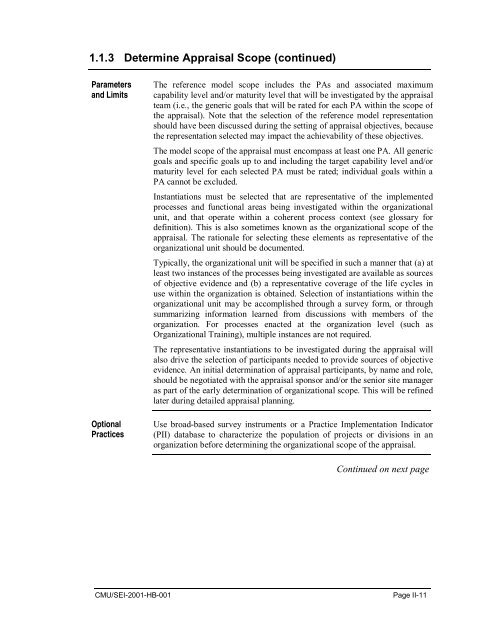Standard CMMI Appraisal Method for Process Improvement (SCAMPI)
Standard CMMI Appraisal Method for Process Improvement (SCAMPI)
Standard CMMI Appraisal Method for Process Improvement (SCAMPI)
You also want an ePaper? Increase the reach of your titles
YUMPU automatically turns print PDFs into web optimized ePapers that Google loves.
1.1.3 Determine <strong>Appraisal</strong> Scope (continued)<br />
Parameters<br />
and Limits<br />
Optional<br />
Practices<br />
The reference model scope includes the PAs and associated maximum<br />
capability level and/or maturity level that will be investigated by the appraisal<br />
team (i.e., the generic goals that will be rated <strong>for</strong> each PA within the scope of<br />
the appraisal). Note that the selection of the reference model representation<br />
should have been discussed during the setting of appraisal objectives, because<br />
the representation selected may impact the achievability of these objectives.<br />
The model scope of the appraisal must encompass at least one PA. All generic<br />
goals and specific goals up to and including the target capability level and/or<br />
maturity level <strong>for</strong> each selected PA must be rated; individual goals within a<br />
PA cannot be excluded.<br />
Instantiations must be selected that are representative of the implemented<br />
processes and functional areas being investigated within the organizational<br />
unit, and that operate within a coherent process context (see glossary <strong>for</strong><br />
definition). This is also sometimes known as the organizational scope of the<br />
appraisal. The rationale <strong>for</strong> selecting these elements as representative of the<br />
organizational unit should be documented.<br />
Typically, the organizational unit will be specified in such a manner that (a) at<br />
least two instances of the processes being investigated are available as sources<br />
of objective evidence and (b) a representative coverage of the life cycles in<br />
use within the organization is obtained. Selection of instantiations within the<br />
organizational unit may be accomplished through a survey <strong>for</strong>m, or through<br />
summarizing in<strong>for</strong>mation learned from discussions with members of the<br />
organization. For processes enacted at the organization level (such as<br />
Organizational Training), multiple instances are not required.<br />
The representative instantiations to be investigated during the appraisal will<br />
also drive the selection of participants needed to provide sources of objective<br />
evidence. An initial determination of appraisal participants, by name and role,<br />
should be negotiated with the appraisal sponsor and/or the senior site manager<br />
as part of the early determination of organizational scope. This will be refined<br />
later during detailed appraisal planning.<br />
Use broad-based survey instruments or a Practice Implementation Indicator<br />
(PII) database to characterize the population of projects or divisions in an<br />
organization be<strong>for</strong>e determining the organizational scope of the appraisal.<br />
Continued on next page<br />
CMU/SEI-2001-HB-001<br />
Page II-11
















